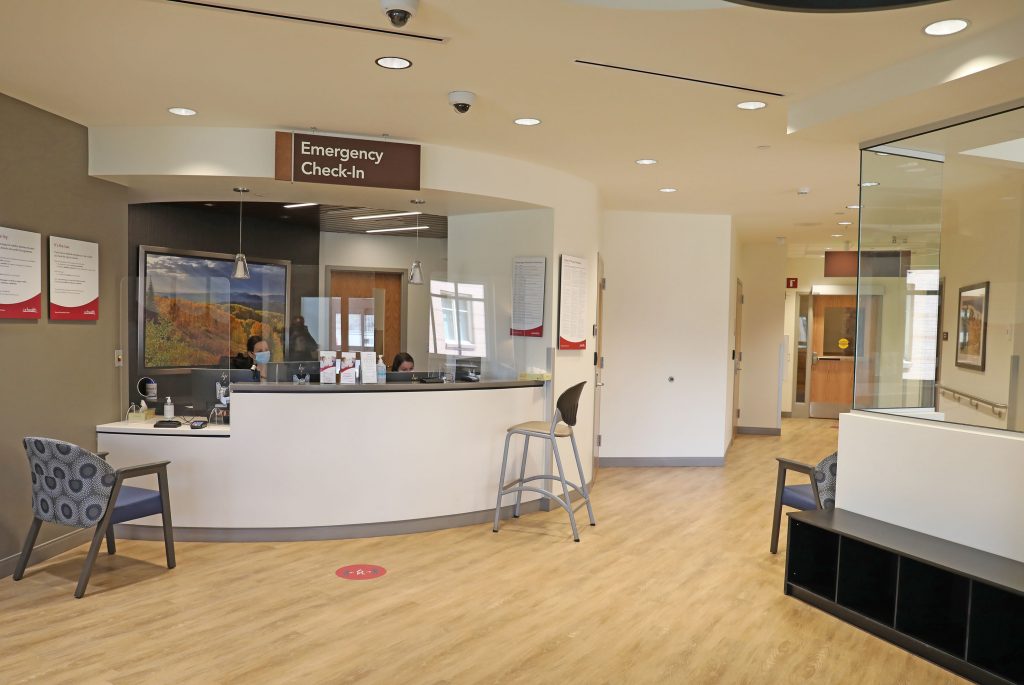Steamboat hospital’s newly expanded emergency department gets major test on its first day (with photo gallery)
$10 million emergency department renovation complete at UCHealth Yampa Valley Medical Center
On what should have been a slow mud season Thursday afternoon, the freshly renovated emergency department at UCHealth Yampa Valley Medical Center was put to the test on the first official day of its completion.
Within a span of 60 minutes, nine patients arrived at the hospital’s emergency department May 6 with conditions ranging from nonurgent to emergent, according to Lindsey Reznicek, hospital communications specialist. The patient in the most serious condition was wheeled directly through the back double doors of the new, ultra-modern trauma room and immediately surrounded in a flurry of care by four EMS crew, four nurses and two surgeons.
During a tour of the department the following Friday, it was obvious the previous day had been dramatic for the trauma staff. That high volume of emergency patients within an hour might not happen frequently for the local hospital, but multiple emergency situations are increasing, Emegency Department Nurse Manager Debbie Kennedy said.
Now the updated department is fully prepared after a $10 million remodel that took 15 months of carefully coordinated work that never stopped the 24-hour services. Part of the important upgrades are two major trauma rooms that are more than double in size in comparison to previous rooms.
“The space alone allows us to care for patients head to toe and do full assessments to take care of critical measures in a timely manner,” nurse Erin Weber said. Emergency department team members believe the renovated trauma rooms provide more safety for staff and patients and an improved quality of care for patients.
Soniya Fidler, president of the Steamboat hospital, said the renovation brings the previous emergency facilities built in 1999 “on par with the tremendous level of care delivered by our dedicated physicians and staff.”
“It’s important to continually reinvest in our facilities to ensure they’re meeting the needs and expectations of our patients,” Fidler said.
The 340-square-foot major trauma room includes an overhead boom for easy access and efficient maneuvering of critical equipment, such as a cardiac monitor, oxygen controls, suction and monitors for vital signs. The trauma gear includes a high-quality ultrasound machine, rapid blood infuser and wall of glass-door cabinets with supplies organized by bodily systems.
Julie McFadden, trauma program nurse manager, said the major trauma room is set up to stabilize patients with any conditions, and the facility and staff can care for almost any emergency patient situation locally short of complex pelvic fractures, multisystem blunt trauma or intubations that last more than 24 hours.
The department was completely redesigned and enlarged from approximately 7,600 to 10,600 square feet. The first step last year was relocating the hospital’s pharmacy, a cardio-pulmonary area and another office to make room. Now the emergency department features an efficient raceway design where medical staff work in the middle surrounded by 14 private patient rooms for better access and monitoring. The patient rooms also include two safe rooms, two negative pressure rooms and a forensic nurse exam room. Gone are patient bays separated only by curtains with no sound privacy.
In the safe room, a door can be rolled down to hide all medical equipment for safety in the case of a patient with a mental health situation. Since Routt County has no detox facility, individuals intoxicated or impaired by drugs may spend time in the safe room.
Kennedy said the hospital employs quick registration where all emergency patients give their name, birth date and why they are there, and then patients can proceed directly to care, with paperwork completed later at the bedside.
The emergency department rooms are designed as multipurpose and stocked with the same arrangement so that nurses can employ muscle memory in the fast-paced environment and do not need to leave the patient to gather supplies, Kennedy said.
The department also adds some new, well-conceived facilities, such as a decontamination room with a direct exterior entrance door, second negative pressure room for use in the case of airborne disease mitigation, secured medication prep room, confidential consultation room for physicians and a small private lounge for EMS personnel.
The renovation added a second entrance to separate patients who arrive on their own and are able to walk from patients arriving on stretchers via ambulance or medical helicopter. The headquarters for hospital security is stationed between the two important entrances.
The busiest months for the department are March, with an average of 34 patients per day during the past five years, and July, averaging 27 patients per day, Reznicek said.
The hospital’s foundation raised more than $2.3 million toward the project to update the Level III trauma center. Karen Schneider, foundation executive director, said the “philanthropic aspect of this project has been a true partnership with our community — we did this together.”
“We were fortunate to raise $2.3 million thanks to the generosity of individual and corporate donors as well as community members who participated in past Foundation events” including fundraisers from 2016 to 2019, Schneider said.
To reach Suzie Romig, call 970-871-4205 or email sromig@SteamboatPilot.com.

Support Local Journalism

Support Local Journalism
Readers around Steamboat and Routt County make the Steamboat Pilot & Today’s work possible. Your financial contribution supports our efforts to deliver quality, locally relevant journalism.
Now more than ever, your support is critical to help us keep our community informed about the evolving coronavirus pandemic and the impact it is having locally. Every contribution, however large or small, will make a difference.
Each donation will be used exclusively for the development and creation of increased news coverage.


















